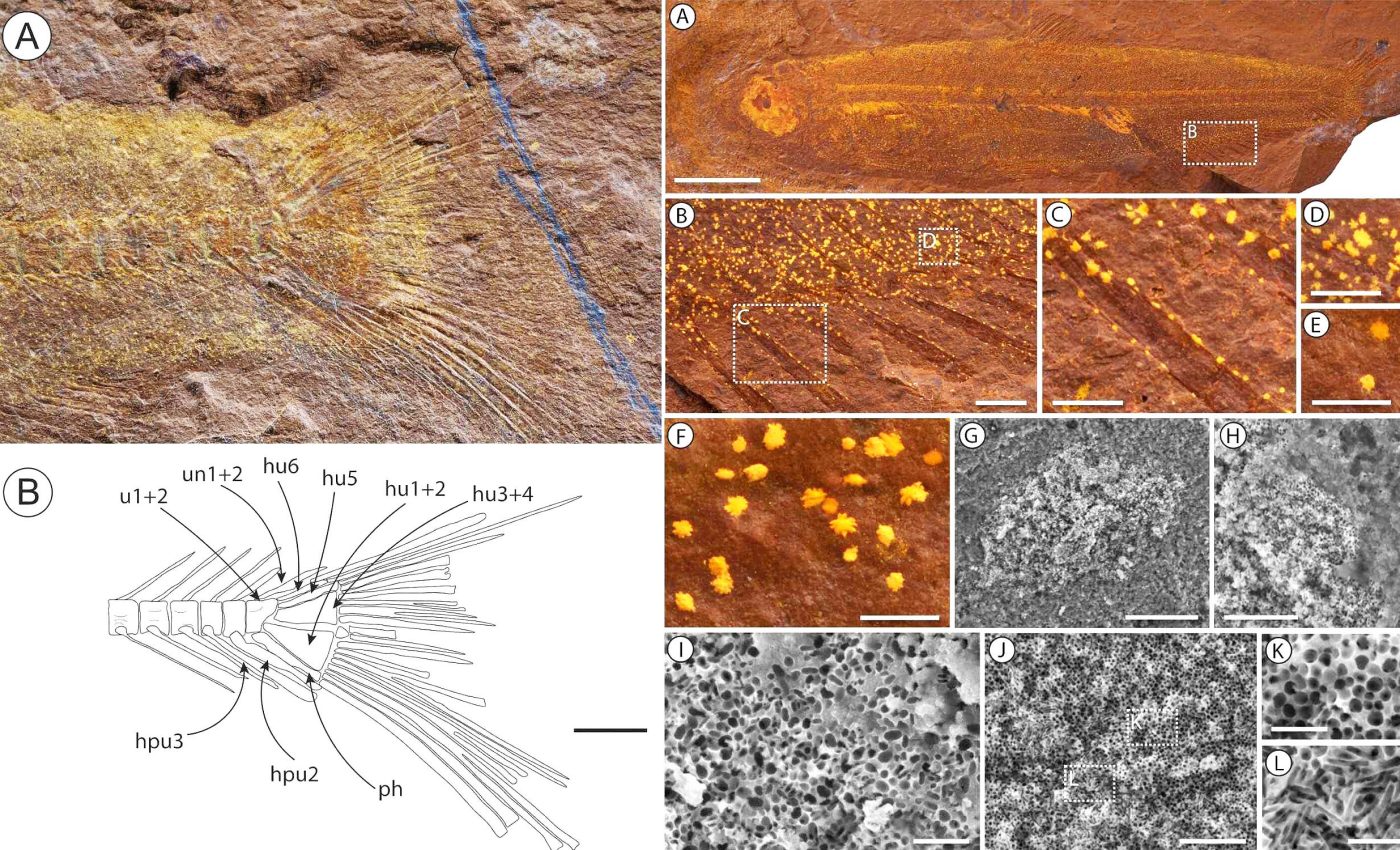
Fossilized fish that lived 15 million years ago still has preserved food in its stomach
The fossil of Ferruaspis brocksi lay unnoticed inside a small slab of rust‑colored rock from a newly discovered exceptional fossil site in central New South Wales, Australia until a curious researcher split the stone in early March.
“It was a complete fluke,” exclaimed Prof. Jochen Brocks of the Australian National University after realizing what he had found.
That single break exposed a two‑inch fish so complete that even its stomach contents and color cells were still visible.
During the Miocene epoch, central New South Wales was covered by temperate rainforest and freshwater oxbow lakes rather than today’s dusty paddocks.
The new species belongs to the Osmeriformes order, a group better known for modern graylings and smelts but never before recorded in Australia’s fossil record.
Researchers led by Dr. Matthew McCurry at the Australian Museum and Dr. Michael Frese at the University of Canberra compared dozens of specimens ranging from 2.1 to 3 inches long, confirming a healthy resident population rather than scattered migrants.
Rainforest lake that turned to rust
The fish and many plants and insects were entombed in goethite, an iron‑oxide mineral that precipitated rapidly in the stagnant lake water.
Iron’s ability to lock soft tissue in place is now recognized as a key factor in deep‑time preservation of cells and proteins.
Geochemists note that goethite’s fine crystals can replicate sub‑micron features before decay destroys the originals, explaining why pigment cells survived here while bones often did not.
McGraths Flat is classed as a Konservat‑Lagerstätte, a sedimentary deposit famous for extraordinary detail, and its ferric layers sit just three feet below the surface near Gulgong.
The discovery encourages field crews to re‑examine iron‑rich outcrops worldwide that were once dismissed as fossil‑poor.
Fish fossil was a two‑inch hunter
Under a scanning electron microscope, the team identified packed groups of melanosomes that once sat inside pigment cells called melanophores.
Their distribution shows a dark back, pale belly, and two lateral racing stripes, classic countershading that helps living fish blend into sunlit water.
“It pushed the boundaries of what can be preserved,” noted Dr. Frese. Similar spherical and rod‑shaped melanosomes had been recorded earlier in an Eocene fish eye from Denmark, providing a useful comparison for the Australian material.
The stripes also hint at schooling behavior, because bold horizontal bands are common in small modern smelts that rely on group camouflage.
What a final snack reveals
Each fossil gut contained antennae from Chaoborus larvae, better known as phantom midge young, along with fragments of insect wings and an occasional bivalve shell.
Modern Chaoborus sink into mud by day and rise at night to avoid fish, a strategy documented in laboratory and field studies.

The heavy reliance on pelagic prey suggests F. brocksi hunted in open water after dusk rather than picking along the bottom.
Because several size classes died together, scientists infer the lake provided year‑round habitat, unlike many living smelts that migrate between rivers and the sea.
A parasite hitchhiker
One specimen shows a juvenile freshwater mussel, or glochidium, clamped to its tail fin. This is the oldest direct fossil record of such parasitism and implies the lake was periodically connected to a river where adult unionid mussels spawned.
Another fish swallowed a similar mussel, meaning it likely ventured near the river mouth shortly before dying.
These clues help reconstruct seasonal flooding patterns in Miocene Australia without relying solely on sedimentology.
Why iron fish fossils matter
Palaeontologist Kate Trinajstic, Curtin University, observed that iron deposits “open up a new area for people to investigate.”
Her point is underscored by experimental decay work showing that early iron infiltration can arrest bacterial breakdown within days.
Goethite fossils therefore extend the window for studying fragile tissues like eyes, muscles, and even viral particles that normally vanish.
They also capture ecological interactions, predation, parasitism, pigmentation, that skeletons alone cannot.
Rethinking Australia’s fossil record
The discovery of Ferruaspis brocksi challenges the long-held notion that Australia’s freshwater fish fossil record is too sparse for meaningful evolutionary study.
Until now, no complete body fossils of Osmeriformes had been found on the continent, leaving major gaps in understanding their arrival and development.
With dozens of specimens at a single site, paleontologists now have a rare opportunity to study not just anatomy, but behavior, ecology, and population structure.
This level of detail is nearly unheard of in Miocene freshwater fish fossils from the Southern Hemisphere.
The team’s phylogenetic analysis places F. brocksi near the base of the southern Osmeriformes radiation, pushing the group’s Australian arrival to at least 15 million years ago.
That timeline aligns with molecular studies indicating a mid‑Miocene split between Australian and New Zealand graylings. Fieldwork will resume next dry season, targeting deeper layers that may hold older relatives or their predators.
The study is published in the Journal of Vertebrate Paleontology.
—–
Like what you read? Subscribe to our newsletter for engaging articles, exclusive content, and the latest updates.
Check us out on EarthSnap, a free app brought to you by Eric Ralls and Earth.com.
—–













